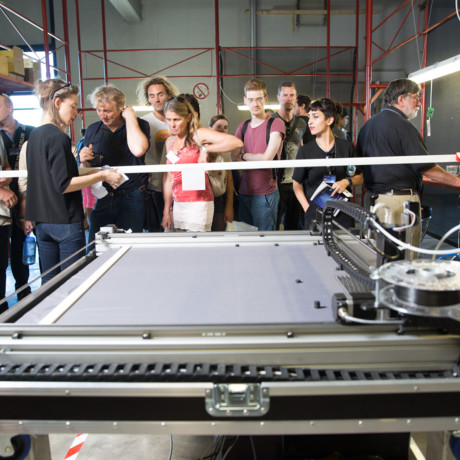
Fold Printing
RESEARCH THROUGH MAKING
Fold Printing evolved out of the understanding that folding textiles was possible through rigid panels and the flexible hinges. Initial experiments began with screen printing resins onto felts and other absorbant textiles. The process led to a sudden insight that 3D printing could be used to deposit a thin layer of plastic in negative shape of the crease pattern (the lines that make up an origami pattern). The process was full of trial-and-error with smaller printers that eventually led to success and the construction of two large format 3D printers. The first was deconstructed to make way for the second more rigid version with two printer heads. The process of construction and design was very involved, it resulted in many side-routes to solve and gather technical solutions to work with open-source printer control software, otherwise known as firmware. The end results speak for themselves. The highly refined process has excellent qualities for robotic and kinetic origami formation. In fact, as discussed in the paper, the process is one of the fastest folding techniques that the team have ever experienced. The production process is time consuming, however the Niwashi printer is reliable enough to leave printing.
This page contains several videos and a link to our paper below.
Videos
The videos are presented on the page, above, or you may view them directly on vimeo.comSpeed Foldability compares the folding process of timed first time foldings of a given pattern in laser scored washi vs fold printed textiles (FPT) See https://vimeo.com/285747373
Niwashi Large Format Fold Printer introduces the printer and the process https://vimeo.com/286778516
Materiality highlights the textural, tactile, flexibile qualities of a Fold Printed Miura-ori (herringbone style) pattern. https://vimeo.com/285746097
Paper
The following abstract is from our paper: Fold Printing: Using Digital Fabrication of Multi-Materials for Advanced Origami Prototyping
Computational Origami invents a new kind of complexity: the highly irregular crease pattern, posing a significant challenge to foldability. We design a method for digital fabrication of multi-material composites to overcome issues of foldability and durability faced when producing functional prototypes with paper. Our fabrication method, called Fold Printing, uses off-the-shelf and customised 3D printing technology, heat pressing, and elastomers to control fold memory in Folded Polymer Textile Elastomer Composites (FPTEC). Our results show that Fold-Printing affords foldability of high-irregularity crease patterns, and can produce durable advanced origami prototypes.
Gardiner, M., Aigner, R., Ogawa, H., Reitböck, E., & Hanlon, R. (2018). Fold Printing: Using Digital Fabrication of Multi-Materials for Advanced Origami Prototyping. In 7th Origami Science Mathematics and Eductation Conference. Presented at the 7OSME, Oxford, Great Britain.
Download the paper as a PDF
Download the paper as a PDF

Computational Origami invents a new kind of complexity: the highly irregular crease pattern, posing a significant challenge to foldability. We design a method for digital fabrication of multi-material composites to overcome issues of foldability and durability faced when producing functional prototypes with paper.

